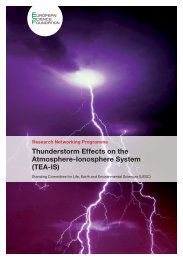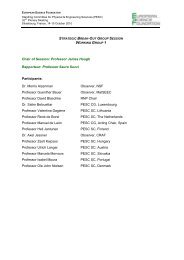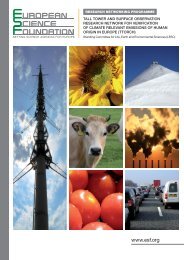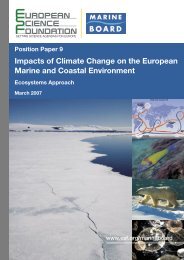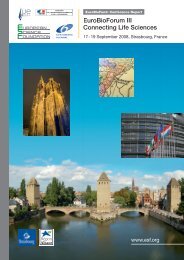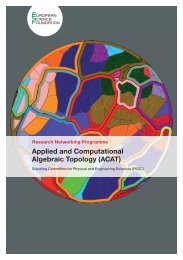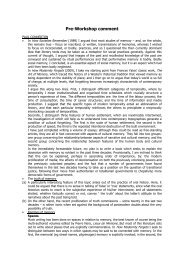European Peer Review Guide - European Science Foundation
European Peer Review Guide - European Science Foundation
European Peer Review Guide - European Science Foundation
Create successful ePaper yourself
Turn your PDF publications into a flip-book with our unique Google optimized e-Paper software.
72<br />
<strong>European</strong> <strong>Peer</strong> <strong>Review</strong> <strong>Guide</strong><br />
Exceptions may be smaller awards, such as databases<br />
described above.<br />
Although timelines may inevitably be protracted,<br />
mechanisms should be incorporated to minimise<br />
delays.<br />
9.3 Processing of applications<br />
In evaluating research infrastructure projects it is<br />
essential to consider the full life-cycle of the project<br />
– from concept and construction to operation and<br />
phase-out. Though it is essential that the funding<br />
should facilitate long-term planning and promote<br />
long-term projects in operating and using infrastructures,<br />
a proposal has to focus on the funding period<br />
which could for instance be a five-year term.<br />
Two particular aspects of the peer review when<br />
applied to RI are eligibility and evaluation criteria.<br />
The first set of criteria will determine which proposals<br />
are accepted to go through the peer review and<br />
which ones will not be accepted. Evaluation criteria<br />
are used for the peer review and selection process<br />
to determine comparative merits of competing proposals.<br />
9.3.1 Eligibility criteria<br />
Applicants will generally be eligible research bodies<br />
or institutions, although in other cases applications<br />
may be made directly by scientists, with commitment<br />
of support from the host institution. National<br />
eligibility criteria will apply.<br />
9.3.2 Evaluation criteria<br />
The evaluation concerns not only the scientific quality<br />
of the proposal and competence of the applicants,<br />
but also the detailed evaluation of the infrastructure<br />
itself. National or <strong>European</strong> priorities might<br />
play a significant role as well. Usually, the criteria for<br />
assessing proposals on research infrastructure will<br />
comprise the scientific excellence of the research to<br />
be performed, the management of the infrastructure,<br />
and the service the infrastructure can provide.<br />
A set of criteria could, for instance, verify that the<br />
infrastructure should:<br />
• Provide scope for unique, outstanding research;<br />
• Represent a truly relevant resource to be used<br />
by several research groups/users with highly<br />
advanced research projects;<br />
• Be of broad national or <strong>European</strong> interest;<br />
• Have clear plans for maintenance and management<br />
of the infrastructure;<br />
• Have a long-term plan addressing scientific goals,<br />
financing and use;<br />
• Be open and easily accessible for researchers and<br />
have a plan for improving accessibility (concerns<br />
both use of the infrastructure, access to collected<br />
data and presentation of results).<br />
Other criteria that may be addressed are:<br />
• Training requirements and availability of the programmes<br />
(e.g., seminars, workshops) associated<br />
with the infrastructures;<br />
• Concepts for scientific service (e.g., sample preparation,<br />
data analysis, etc.);<br />
• Contribution to the development or enhancement<br />
of relevant standards.<br />
Apart from judging the fulfilment of the criteria<br />
above, there is also an assessment of the infrastructure’s<br />
relevance to the research that it intends<br />
to support. In addition, an assessment of the infrastructure’s<br />
potential users is also included in the<br />
evaluation.<br />
9.3.3 Budget<br />
Financing for research infrastructures is usually<br />
long-term funding. Financing should aim to achieve<br />
a balance between investment and operational<br />
resources and resources to enable researchers to use<br />
the infrastructures. A planning grant, which could<br />
run for one or two years, is adequate when an infrastructure<br />
is in a preparatory phase. The planning<br />
grant will essentially cover costs for salaries, meetings,<br />
maintenance of the equipment, training, etc.<br />
An investment grant is suitable for an infrastructure<br />
in the construction phase and would fund<br />
essentially equipment and salaries/material for the<br />
construction.<br />
Finally, for an infrastructure in operation, an<br />
operation grant, which would essentially fund<br />
operational costs like energy, rent and salaries, is<br />
adequate.<br />
Governance and management plans will be<br />
essential to include in the budgets presented for<br />
evaluation. It may be suitable to have:<br />
• Different budget lines for the different phases of<br />
a research infrastructure;<br />
• Supplementary awards for usage – but also avoiding<br />
double costing on awards;<br />
• Personnel dedicated to building up infrastructure<br />
as opposed to those engaged directly in research<br />
need to be included.




